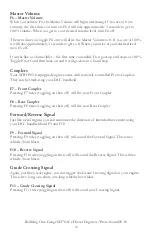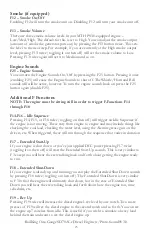
RailKing One-Gauge SD70ACe Diesel Engine w/Proto-Sound® 3.0
36
NOTE
: CV21 is ONLY used when you have some value other than 0 written to CV19. If
CV19 = 0 then the values of CV21, CV22, CV23, and CV24 are not used
3. Call up your Middle engine (address 2 in the example)
4. Since you want to have the Middle engine respond to F3 only then write a value of 4
(CV21, bit 2 = ON)
5. Call up your Rear engine (address 3 in the example)
6. Since you want to have the Rear engine respond to the Start-Up/Shut Down (F3) and
Rear Coupler (F8) functions you want to write a value of 132 to CV21
Your engines are now set up according to the example above.
You will note that there is no F0 in CV21. This is because that function (FL) is controlled
by CV22. Please refer to the Advanced Consisting section for more information regarding
CV22.
Programming Track
Your MTH Proto-Sound 3.0-equipped locomotive does not program well on
Programming tracks due to the inclusion of super capacitors utilized in the locomotive's
electronic package. The super capacitors provide backup power to the electronics,
allowing the locomotive to better negotiate track sections suffering from poor electrical
conductivity. This ensures that sounds continue to play, the locomotive continues to
move forward and lighting remains lit. During power shutdowns, the super capacitors
provide power to allow the locomotive shutdown sounds to continue playing through
their conclusion. Unfortunately, the super capacitors require that operators ONLY
program engine CV’s using Programming on the Main (PoM).
DCC Bit Value Decoder
Decimal
Value
128
0
16
0
0
1
64
8
Example Value (bit 7 -> bit 0) 11011001
Binary
Example
1 (on)
Bit
(Decimal
Value)
7 (128)
5 (32)
4 (16)
3 (8)
2 (4)
1 (2)
0 (1)
6 (64)
1 (on)
1 (on)
1 (on)
1 (on)
1 (on)
0 (off)
0 (off)
0 (off)
















































